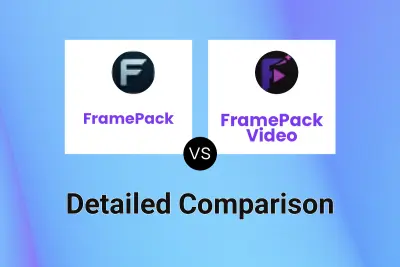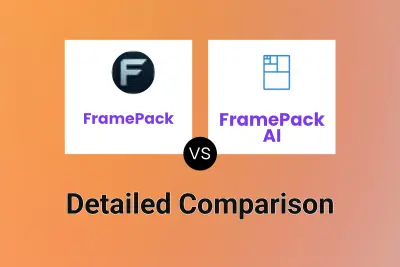 FramePack
VS
FramePack
VS
 FramePack AI
FramePack AI
FramePack
FramePack introduces a groundbreaking video diffusion technology designed to make high-quality video generation accessible on standard consumer hardware. Its core innovation allows users to run sophisticated video creation processes locally, requiring only a GPU with 6GB of VRAM. This significantly lowers the barrier to entry for AI-driven video production, eliminating the need for expensive cloud processing or high-end GPU rentals.
The technology leverages efficient frame context packing and maintains a constant-length input, enabling next-frame prediction with remarkable temporal consistency. FramePack incorporates anti-drifting technology through bi-directional sampling, ensuring that video quality remains stable even over longer sequences. It supports multimodal inputs, accepting both text prompts and initial images to guide the generation process, offering flexibility for various creative workflows directly on the user's device.
FramePack AI
Developed by researchers at Stanford University, FramePack AI introduces a novel neural network structure designed to enhance the capabilities of AI video generation models, particularly for long-form content. It directly confronts the 'forgetting-drifting dilemma' – the challenge where models either lose track of early content details or suffer from accumulating visual errors over time. By implementing progressive frame compression, FramePack AI intelligently reduces the data load of less critical frames, allowing it to maintain a fixed computational context length irrespective of the video's total duration. This breakthrough enables the processing of substantially longer video sequences without escalating computational demands.
The architecture incorporates unique anti-drifting sampling techniques that generate video frames with bi-directional context, significantly mitigating the quality degradation often seen in extended AI-generated videos. FramePack AI is designed for compatibility, allowing integration with existing pretrained video diffusion models through fine-tuning, bypassing the need for complete retraining. This efficiency extends to the training process itself, enabling larger batch sizes comparable to image diffusion models, thus accelerating development and improving the overall quality and temporal consistency of generated video content.
Pricing
FramePack Pricing
FramePack offers Freemium pricing .
FramePack AI Pricing
FramePack AI offers Pay Once pricing .
Features
FramePack
- Low VRAM Requirements: Operates on consumer GPUs with just 6GB of VRAM.
- Local Execution: Generates videos directly on user hardware, ensuring privacy and no cloud dependency.
- Anti-Drifting Technology: Employs bi-directional sampling to maintain consistency in long video sequences.
- Frame Context Packing: Efficiently compresses frame information for processing on standard hardware.
- Next-Frame Prediction: Generates video sequences frame by frame.
- Optimized Performance: Achieves ~1.5 seconds per frame generation on high-end GPUs (with Teacache).
- Open Source Access: Provides a fully open-source implementation for community contribution and customization.
- Multimodal Input: Supports both text prompts and image inputs for video guidance.
FramePack AI
- Fixed Context Length: Maintains constant computational requirements independent of input video length.
- Progressive Compression: Optimizes memory by applying higher compression to less important frames while preserving key visuals.
- Anti-Drifting Sampling: Employs novel sampling strategies (Vanilla, Anti-Drifting, Inverted Anti-Drifting) to prevent error accumulation and quality loss.
- Compatible Architecture: Integrates with existing video diffusion models like HunyuanVideo and Wan through fine-tuning.
- Balanced Diffusion: Supports diffusion schedulers with less extreme flow shifts for enhanced visual quality.
- Higher Batch Sizes: Allows training with batch sizes similar to image diffusion models (e.g., 64 samples/batch), accelerating the training process.
Use Cases
FramePack Use Cases
- Creating short fashion videos.
- Developing product showcase videos.
- Generating sequences for travel documentaries.
- Producing food exploration content.
- Animating sports highlights.
- Making creative advertisements.
- Visualizing daily life moments.
- Generating nature scenery videos.
- Prototyping video concepts quickly.
- Creating animations for independent projects.
- Assisting VFX specialists with concept generation.
- Facilitating AI video generation research on standard lab equipment.
FramePack AI Use Cases
- Generating extended, high-quality videos without significant quality degradation or computational increase.
- Converting static images into dynamic, temporally consistent video sequences.
- Creating videos from textual descriptions with improved narrative consistency and visual stability.
- Expanding existing short video clips into longer, coherent narratives.
- Animating photographs while preserving the subject's identity and introducing natural movement.
FAQs
FramePack FAQs
-
What are the system requirements for FramePack?
FramePack requires an NVIDIA GPU with at least 6GB VRAM (e.g., RTX 3060), CUDA support, PyTorch 2.6+, and runs on Windows or Linux. An RTX 30 or 40 series GPU with 8GB+ VRAM is recommended for better performance. -
How fast can FramePack generate videos?
On high-end GPUs like the RTX 4090 with Teacache optimization, FramePack generates frames at about 1.5 seconds per frame. Generation is 4-8 times slower on laptops with 6GB VRAM. -
What is 'frame context packing' in FramePack?
Frame context packing is FramePack's technique to efficiently compress information from previous frames into a constant-length format, enabling consistent video generation without escalating memory needs. -
How does FramePack address 'drifting' in video generation?
FramePack uses bi-directional sampling, which references initial frames throughout the generation process to maintain consistent subject identity and scene composition, thus preventing quality degradation over long sequences.
FramePack AI FAQs
-
What makes FramePack different from other video generation approaches?
FramePack solves the forgetting-drifting dilemma using progressive frame compression for a fixed context length, addressing both memory limits and error accumulation simultaneously, while maintaining efficiency comparable to image diffusion models. -
Can FramePack be integrated with my existing video generation pipeline?
Yes, it is designed for compatibility and can be integrated with existing pretrained video diffusion models (like HunyuanVideo and Wan) through fine-tuning, avoiding the need for complete retraining. -
What hardware requirements are needed to implement FramePack?
FramePack is efficient; training a 13B parameter model at 480p can use a batch size of 64 on a single 8×A100-80G node. Inference can run on a single A100-80GB or potentially 2x RTX 4090s. -
How does FramePack handle different video resolutions and aspect ratios?
It supports multi-resolution training using aspect ratio bucketing, allowing flexible handling of various resolutions (e.g., 480p tested) and aspect ratios. -
Is FramePack suitable for real-time applications?
While primarily focused on high-quality generation, its computational efficiency and fixed context length show promise for potential real-time applications with further optimization, especially for streaming or interactive scenarios.
Uptime Monitor
Uptime Monitor
Average Uptime
0%
Average Response Time
0 ms
Last 30 Days
Uptime Monitor
Average Uptime
100%
Average Response Time
376.6 ms
Last 30 Days
FramePack
FramePack AI
More Comparisons:
Didn't find tool you were looking for?


